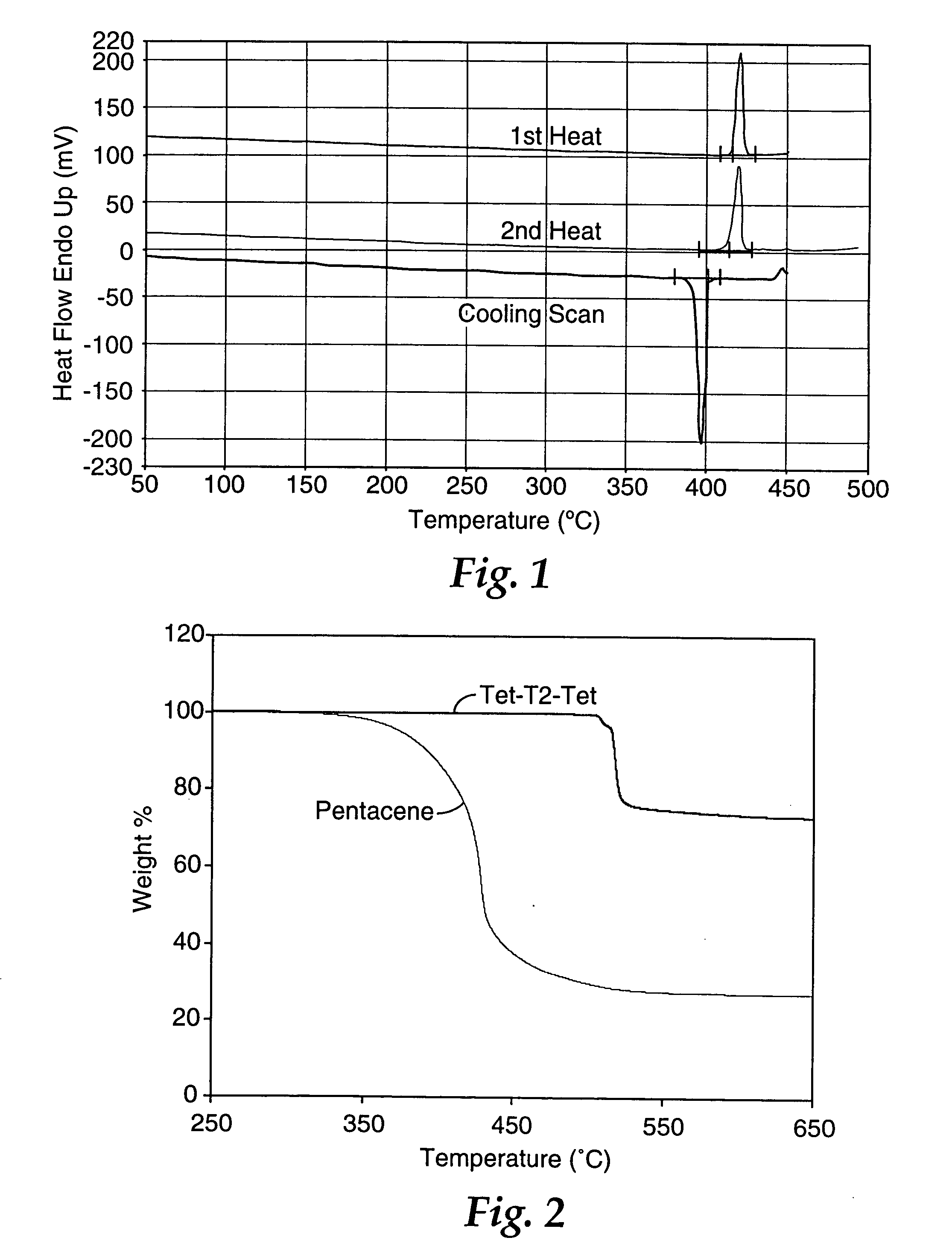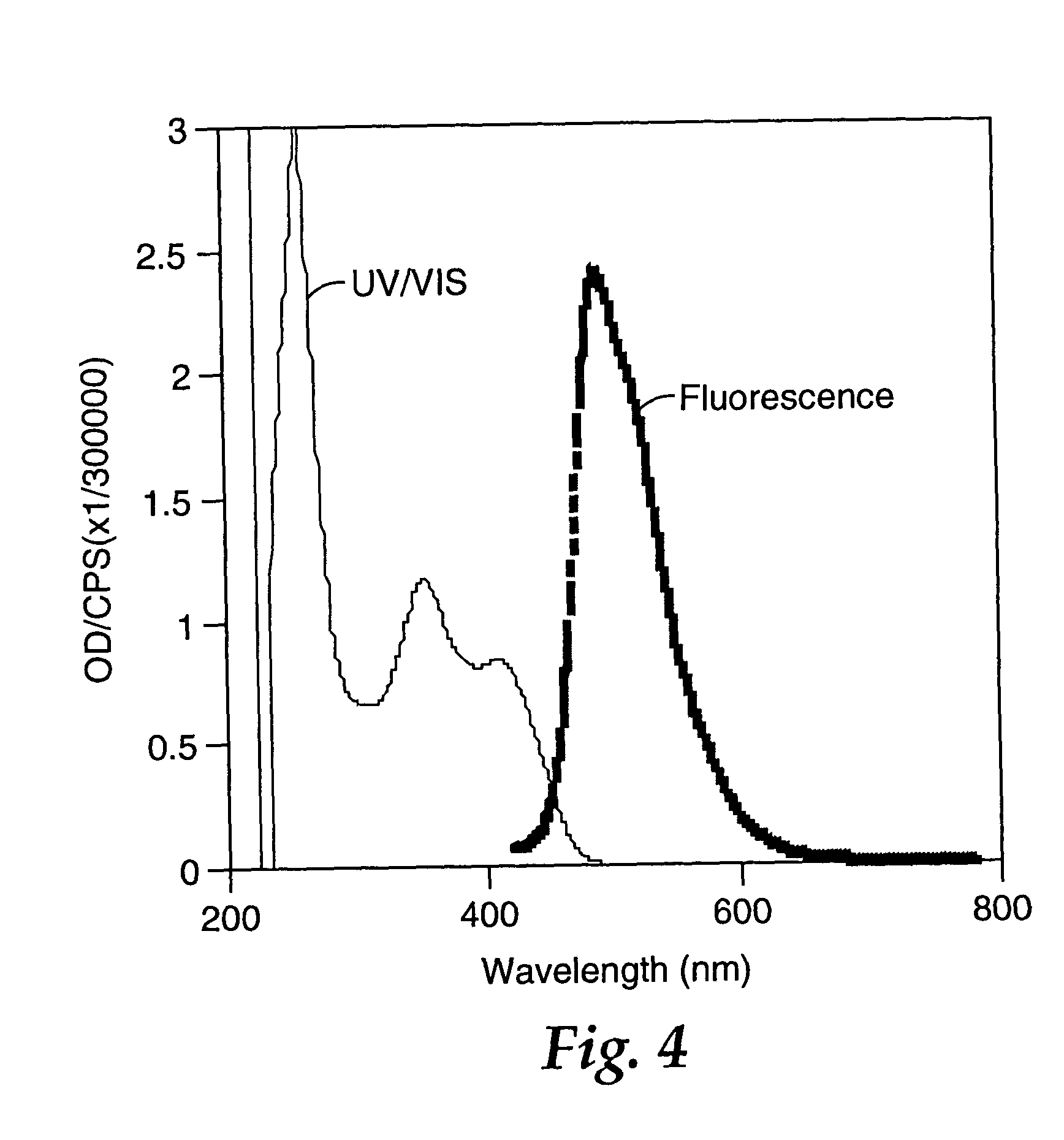Acene-thiophene semiconductors
a technology of acenethiophene and semiconductors, applied in the field of organic compounds, can solve the problems of poor device performance, unknown long-term oxidative and thermal stability of pentacene, etc., and achieve the effect of high performance, useful performance and stability in the devi
- Summary
- Abstract
- Description
- Claims
- Application Information
AI Technical Summary
Benefits of technology
Problems solved by technology
Method used
Image
Examples
example 1
Synthesis of 5,5′-bis(2-anthracenyl)-2,2′-bithiophene (An-T2-An)
A 100 mL Schlenk flask was loaded with 5,5′-bis(tri-n-butylstannyl)-2,2′-bithiophene (3.16 g, 4.25 mmol), DMF (40 mL), 2-bromoanthracene (2.19 g, 8.50 mmol), and Pd(PPh3)4 (114 mg, 98.7 mmol, 2.3 mmol %). The suspension was bubbled through with N2 for 20 min, and then warmed with a hot oil bath. At 80° C., all solids dissolved and the mixture became homogenous; at 105° C., a bright, fine orange ppt formed. The reaction was stirred at 110° C. for 14 h and then cooled to room temperature. The mixture was poured on to a glass filter frit (10-20 μm pores) and successively washed with water, IN HCl, acetone, and then air dried to yield 2.012 g of orange product. The material was purified by gradient sublimation at a source temperature of 320° C. to afford 1.60 g (73%) of product. DSC data: peak temp 420° C. (reversible mp, ΔH=246 Jg−1). LDMS. m / z 518.1276 (M+), no other ions were detected in the sample. Fluorescence spect...
example 2
Synthesis of 5.5′-bis(2-tetracenyl)-2.2′-bithiophene (Tet-T2-Tet)
A vessel was successively charged with Pd2(dba)3 (103 mg, 0.112 mmol, 1.5%), CsF (2.54 g, 16.7 mmol, 2.2 eq), dioxane (120 mL), 2-chlorotetracene (2.00 g, 7.61 mmol), 5,5′-tri-n-butylstannyl-2,2′-bithiophene (2.83 g, 3.81 mmol), P(t-Bu)3 (1.3 mL, 0.45 mmol, 5.9%), and heated at 100° C. for 36 h. The mixture was cooled and poured onto a glass frit (20 μm pores) to isolate a red solid. The crude product was washed with water (100 mL), 5% HCl (aq) (100 mL), additional water, and then air-dried. Gradient sublimation at a source temperature of 400-500° C. afforded 1.25 g (53%) of deep red product. From the coolest zone was isolated 0.33 g of 2-chlorotetracene starting material (17% on input). EIMS: 618 ([M]+, 100%), 309 ([M]2+, 52%). DSC (20° C. / min): 533° C., (mp, ΔH=183 Jg−1). Anal. Calcd. for C44H26S2: C, 85.4; H, 4.23. Found: C, 84.6; H, 4.25. Fluorescence spectrum (saturated CHCl3, right angle geometry, excitation a...
example 3
Synthesis of 5-(2-tetracenyl)-2,2′-bithiophene (Tet-T2)
Pd2(dba)3 (21 mg, 0.023 mmol, 1.5%), CsF (511 mg, 3.37 mmol, 2.2 eq), dioxane (25 mL), 2-chlorotetracene (403 mg, 1.53 mmol), 5-tri-n-butylstannyl-2,2′-bithiophene (766 mg, 1.68 mmol), P(t-Bu)3 (0.26 mL, 0.090 mmol, 6%) were mixed, bubbled with N2 via cannula for 30 min, and then heated at 100° C. for 16 h. An additional charge of 10 mg of Pd[P(t-Bu)3]2 and 140 mg 5-tri-n-butylstannyl-2,2′-bithiophene and heated at 100° C. for another 24 h. Cooled the mixture and poured on a glass filter frit (10-15 μm pores) and washed the reddish crude with Et2O, water, and air-dried. Gradient sublimation at a source temperature of 250-270° C. afforded 443 mg (74%, on 2-chlorotetracene) of bright orange-red product. DSC: 341° C. (mp, ΔH=87 Jg−1). EIMS: 392 ([M]+, 100%), 196 ([M]2+, 20%). Anal. Calcd. for C26H16S2: C, 79.6; H, 4.1. Found: C, 80.0; H, 4.34.
PUM
 Login to View More
Login to View More Abstract
Description
Claims
Application Information
 Login to View More
Login to View More - R&D
- Intellectual Property
- Life Sciences
- Materials
- Tech Scout
- Unparalleled Data Quality
- Higher Quality Content
- 60% Fewer Hallucinations
Browse by: Latest US Patents, China's latest patents, Technical Efficacy Thesaurus, Application Domain, Technology Topic, Popular Technical Reports.
© 2025 PatSnap. All rights reserved.Legal|Privacy policy|Modern Slavery Act Transparency Statement|Sitemap|About US| Contact US: help@patsnap.com



